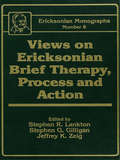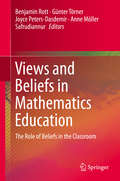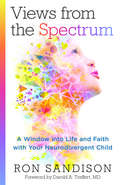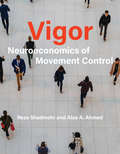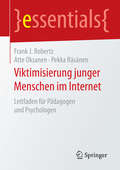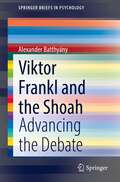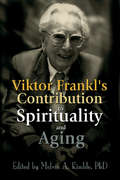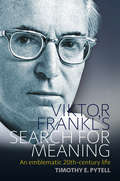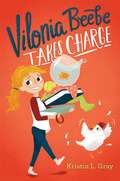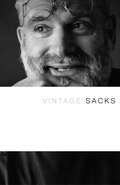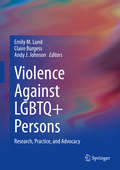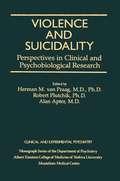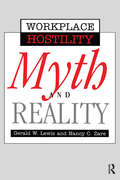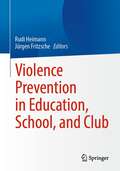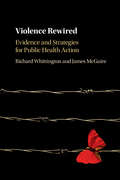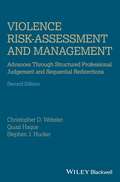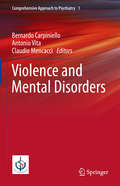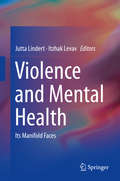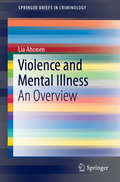- Table View
- List View
Views On Ericksonian Brief Therapy (Ericksonian Monograph Ser. #No.8)
by Jeffrey K. Zeig Stephen R. Lankton Stephen G. GilliganEight papers from the Fourth International Congress on Ericksonian Approaches to Hypnosis and Psychotherapy, held December 1988, San Francisco, California. No index. Annotation copyright Book News, Inc. Portland, Or.
Views and Beliefs in Mathematics Education: The Role Of Beliefs In The Classroom
by Günter Törner Benjamin Rott Joyce Peters-Dasdemir Anne Möller SafrudiannurThe book is made up of 21 chapters from 25 presentations at the 23rd MAVI conference in Essen, which featured Alan Schoenfeld as keynote speaker. Of major interest to MAVI participants is the relationship between teachers’ professed beliefs and classroom practice. The first section is dedicated to classroom practices and beliefs regarding those practices, taking a look at prospective or practicing teachers’ views of different practices such as decision-making, the roles of explanations, problem-solving, patterning, and the use of play. The focus of the second section in this book deals with teacher change, which is notoriously difficult, even when the teachers themselves are interested in changing their practice. The third section of this book centers on the undercurrents of teaching and learning mathematics, what rises in various situations, causing tensions and inconsistencies. The last section of this book takes a look at emerging themes in affect-related research. In this section, papers discuss attitudes towards assessment.
Views from the Spectrum: A Window into Life and Faith with Your Neurodivergent Child
by Ron SandisonA remarkable inside look at the intersection of faith and autism for parents longing to connect their children with God's loveRaising a child with autism is both a challenge and an adventure--and sometimes parents need to know there can also be wonderful potential for blessings. Views from the Spectrum shares the inspiring stories of twenty amazing young adults with autism and how each of their family's unwavering support and faith in God led them to accomplish what was thought impossible. As a thriving adult with autism himself, Ron Sandison is determined to educate the world on the gifts and talents autism can cultivate--even when they differ from our expectations of typical success.While it is primarily a much-needed how-to guide for parents of children with special needs, this book is also a stunning view into the world of autism. Readers will witness the courage of Tyler Gianchetta, who rescued his mother from a burning vehicle. They'll marvel at the artistic talent of nonverbal poet and artist Kimberly Dixon, admire the determination of Armani Williams, competing as a NASCAR driver, and find encouragement in the many other stories within these pages. In addition to these experiences, Sandison has also interviewed top experts in the autism field and shares their insights here.Sandison weaves narrative with Scripture, sharing his own journey with autism throughout the book. Full of anecdotes, scientific research, parenting tips, prayers, devotions, and more, Views from the Spectrum is a celebration of autism, faith, and the possibilities at their intersection.
Vigil
by Morris PanychA man returns after thirty years to sit with a relative on her deathbed. Kemp's problem is: she's not dying fast enough. Through Kemp's own errors and inattentiveness, the visit that he thinks will take a day or two stretches into a year. A play of mistaken identity, twisted circumstance, and surprising turns, this is one Vigil worth keeping.
Vigor: Neuroeconomics of Movement Control
by Reza Shadmehr Alaa A. AhmedAn examination of the link between the vigor with which we move and the value that the brain assigns to the goal of the movement.Why do we reflexively run toward people we love, but only walk toward others? In Vigor, Reza Shadmehr and Alaa Ahmed examine the link between how the brain assigns value to things and how it controls our movements. They find that brain regions thought to be principally involved in decision making also affect movement vigor--and that brain regions thought to be principally responsible for movement also bias patterns of decision making.
Viktimisierung junger Menschen im Internet: Leitfaden für Pädagogen und Psychologen (essentials)
by Frank J. Robertz Atte Oksanen Pekka RäsänenDieses essential gibt einen Überblick über potenzielle Gefahren der Internetnutzung für junge Menschen. Die Autoren befassen sich dabei insbesondere mit Risiken, die aus hassbasiertem Online-Material und möglicherweise schädigenden Inhalten hervorgehen. Ihre Ausführungen werden durch eine Darstellung aktueller Forschungsergebnisse im Ländervergleich ergänzt. Abschließende Empfehlungen zur Verbesserung des Schutzes von Kindern und Jugendlichen im Cyberspace helfen dabei, unserer Verantwortung für die junge Generation besser gerecht zu werden.
Viktor Frankl and the Shoah: Advancing the Debate (SpringerBriefs in Psychology)
by Alexander BatthyányThis books takes a new and critical look at the development of logotherapy and existential analysis, a prominent existential school of psychotherapy. It explores the intellectual and political biography of its founder, the Austrian psychiatrist and holocaust survivor Viktor Frankl, best known for his bestselling “Man’s Search for Meaning”. The book focuses on his life and works and political thinking from the late 1920’s to the years spent in Nazi-occupied Vienna, and finally the time he spent in the concentration camps Theresienstadt, Auschwitz, and Dachau. It presents new archival findings on Frankl’s involvement with the Austrian Zionist Movement, his attempts to sabotage the “euthanasia” program of the National Socialists, and his scathing critiques of the NS-Psychotherapy school around Göring and his students, published during the years before Frankl’s deportation to Theresienstadt. This book addresses recent attempts by the author Timothy Pytell to portray Frankl as a “fellow traveler” of the Nazi regime and corrects the fundamental errors and misrepresentations in Pytell’s work. It thus offers important perspectives on the intellectual history of ideas in psychology and existential psychotherapy, and also serves as key material on the development of psychotherapy before and during the Holocaust.
Viktor Frankl's Contribution to Spirituality and Aging
by Melvin A. KimbleUse Frankl's insights and techniques to improve life for your aging clients or parishioners. Viktor Frankl, a holocaust survivor who experienced firsthand the horrors of Auschwitz, saw man as “a being who continuously decides what he is: a being who equally harbors the potential to descend to the level of an animal or to ascend to the life of a saint. Man is that being, who, after all, invented the gas chambers; but at the same time he is that being who entered into those same gas chambers with his head held high and with the 'Our Father’or the Jewish prayer of the dying on his lips.”Dr. Frankl's insights led him to found the therapeutic system of logotherapy, which views man as a spiritual being rather than simply as a biological construct. Logotherapy has come to be called the Third Viennese School of Psychotherapy (after Freud's psychoanalysis and Adler's individual psychology). He left a rich legacy of theory and insights especially relevant to the search for meaning in later life. The tenets of logotherapy provide many clues and approaches to what an ever-increasing body of evidence suggests regarding the crisis of aging as a crisis of meaning. Frankl&’s insightful work increased man&’s understanding of the spiritual dimension of humanity and the dignity and worth of every person in the face of what he called “the tragic trial of human existence: pain, guilt, and death.”Viktor Frankl's Contribution to Spirituality and Aging presents an essential overview of logotherapy and explores: the search for and the will to meaning in later life the connection between logotherapy and pastoral counseling-bringing psychology and theology together to effectively counsel the aging the role of logotherapy in the treatment of adult major depression aspects of meaning and personhood in dementia the search for meaning in long-term care settingsViktor Frankl's Contribution to Spirituality and Aging represents varying professional perspectives on the application of Frankl's logotherapy for ministry with older adults. The chapter authors represent diverse professional backgrounds in medicine, pastoral theology, the behavioral sciences, and pastoral ministry. They address issues such as death and dying, dementia and depression, and the spiritual meaning of aging, as well as Frankl's conception of the nature of humanity. Everyone interested in the connection between theology and psychology in the context of the aging will want to own this book.
Viktor Frankl's Search for Meaning
by Timothy PytellFirst published in 1946, Viktor Frankl's memoir Man's Search for Meaning remains one of the most influential books of the last century, selling over ten million copies worldwide and having been embraced by successive generations of readers captivated by its author's philosophical journey in the wake of the Holocaust. This long-overdue reappraisal examines Frankl's life and intellectual evolution anew, from his early immersion in Freudian and Adlerian theory to his development of the "third Viennese school" amid the National Socialist domination of professional psychotherapy. It teases out the fascinating contradictions and ambiguities surrounding his years in Nazi Europe, including the experimental medical procedures he oversaw in occupied Austria and a stopover at the Auschwitz concentration camp far briefer than has commonly been assumed. Throughout, author Timothy Pytell gives a penetrating but fair-minded account of a man whose paradoxical embodiment of asceticism, celebrity, tradition, and self-reinvention drew together the complex strands of twentieth-century intellectual life.
Viktor Frankl: A Life Worth Living
by Anna RedsandWhen he was a teenager in Austria, Viktor Frankl began developing logotherapy, a revolutionary form of psychotherapy based on the belief that humanity's primary motivational force is the search for meaning.
Vilonia Beebe Takes Charge
by Kristin L. GrayVilonia is determined to prove she’s responsible enough to care for a dog in this hilarious and utterly lovable debut novel.Being responsible is NOT easy. Fourth grader Vilonia hasn’t lost her rain coat in the three weeks she’s had it and she’s brushed her teeth every night and she’s volunteered to be the Friday Library Helper. But all that hard work is worth it if it means she can get a dog. Besides, this dog isn’t just because Vilonia has wanted one for pretty much ever. It’s also to help Mama, who’s been lost in one, big sadness fog for forty-three days—ever since Nana died. But Vilonia read that pets can help with sadness. Now all she has to do is keep the library goldfish alive over spring break, stop bringing stray animals home, and help Mama not get fired from her job. And she’s got to do all of it before the Catfish Festival. Easy as pie, right? Tremendous voice, humor, and heart make this debut novel utterly lovable.
Vintage Sacks
by Oliver SacksOliver Sacks' empathetic understanding and compelling storytelling ability have turned his accounts of his patients and his own life into literature, as evidenced in "Uncle Tungsten," "Stinks and Bangs," and "Cannery Row" from Uncle Tungsten; the Foreword and "Rose R." from Awakenings; "A Deaf World" from Seeing Voices; and excerpts from "Island Hopping" and "Pingelap" from The Island of the Colorblind.
Vintage Sacks
by Oliver SacksVintage Readers are a perfect introduction to some of the great modern writers presented in attractive, accessible paperback editions."It is Dr. Sacks's gift that he has found a way to enlarge our experience and understanding of what the human is." --The Wall Street JournalDubbed "the poet laureate of medicine" by The New York Times, Oliver Sacks is a practicing neurologist and a mesmerizing storyteller. His empathetic accounts of his patients's lives--and wrily observed narratives of his own--convey both the extreme borderlands of human experience and the miracles of ordinary seeing, speaking, hearing, thinking, and feeling. Vintage Sacks includes the introduction and case study "Rose R." from Awakenings (the book that inspired the Oscar-nominated movie), as well as "A Deaf World" from Seeing Voices; "The Visions of Hildegard" from Migraine; excerpts from "Island Hopping" and "Pingelap" from The Island of the Colorblind; "A Surgeon's Life" from An Anthropologist on Mars; and two chapters from Sacks's acclaimed memoir Uncle Tungsten.From the Trade Paperback edition.
Vintage Sacks
by Oliver SacksVintage Readers are a perfect introduction to some of the great modern writers presented in attractive, accessible paperback editions."It is Dr. Sacks's gift that he has found a way to enlarge our experience and understanding of what the human is." --The Wall Street JournalDubbed "the poet laureate of medicine" by The New York Times, Oliver Sacks is a practicing neurologist and a mesmerizing storyteller. His empathetic accounts of his patients's lives--and wrily observed narratives of his own--convey both the extreme borderlands of human experience and the miracles of ordinary seeing, speaking, hearing, thinking, and feeling. Vintage Sacks includes the introduction and case study "Rose R." from Awakenings (the book that inspired the Oscar-nominated movie), as well as "A Deaf World" from Seeing Voices; "The Visions of Hildegard" from Migraine; excerpts from "Island Hopping" and "Pingelap" from The Island of the Colorblind; "A Surgeon's Life" from An Anthropologist on Mars; and two chapters from Sacks's acclaimed memoir Uncle Tungsten.From the Trade Paperback edition.
Violence Against LGBTQ+ Persons: Research, Practice, and Advocacy
by Andy J. Johnson Emily M. Lund Claire BurgessAs violence against LGBTQ+ persons continues to be a pervasive and serious problem, this book aims to inform mental health providers about the unique needs of LGBTQ+ survivors of interpersonal and structural violence. Individual chapters analyze unique aspects of violence against specific subpopulations of LGBTQ+ persons in order to avoid ineffective and sometimes simplistic one-size-fits-all treatment strategies. Among the topics covered: Macro Level Advocacy for Mental Health Professionals: Promoting Social Justice for LGBTQ+ Survivors of Interpersonal Violence Intimate Partner Violence in Women’s Same-Sex Relationships Violence Against Asexual PersonsInvisibility and Trauma in the Intersex CommunitySexual and Gender Minority Refugees and Asylum Seekers: An Arduous JourneySexual and Gender Minority Marginalization in Military ContextsNavigating Potentially Traumatic Conservative Religious Environments as a Sexual/Gender Minority Violence Against LGBTQ+ Persons prepares mental health professionals for addressing internalized forms of prejudice and oppression that exacerbate the trauma of the survivor, in order to facilitate healing, empowerment, healthy relationships, and resilience at the intersection of sexual orientation, gender identity, gender expression, and diverse social locations. This is a valuable reference for psychologists, social workers, counselors, nurses, mental health professionals, and graduate students, regardless of whether they are preparing for general practice, treatment of LGBTQ+ clients, or treatment of survivors and perpetrators of various forms of violence.
Violence And Suicidality: Clinical And Experimental Psychiatry
by Robert Plutchik Alan Apter Herman M. van PraagFirst published in 1990. This monograph series, published under the auspices of the Department of Psychiatry of the Albert Einstein College of Medicine/Montefiore Medical Center, is meant to keep track of important developments in the profession pf psychiatry, to summarize what has been achieved in particular fields, and to bring together the viewpoints obtained from disparate vantage points-in short, to capture some of the excitement ongoing in modern psychiatry, both in its clinical and experimental dimensions. Violence and suicidality have always been major public health issues, but it is only fairly recently that they have become the focus of some major clinical and biological research efforts. This is due partly to a large increase in suicide and homicide rates in the young and partly to a realization that effective management of psychiatric patients cannot be based on categorical diagnosis alone, but requires an understanding of the patient's entire behavioral profile. This volume attempts to describe some of the most important advances in the psychobiological understanding of the behavioral dimensions of suicide and violence that have been made over the last 10 years. It is comprised of papers presented at two symposia held under the auspices of the department of psychiatry of Albert Einstein College of Medicine that were devoted to the topics of violence and suicide.
Violence In The Workplace: Myth & Reality
by Gerald Lewis Nancy ZareVisit www.geraldlewis.com for more information.
Violence Prevention in Education, School, and Club
by Rudi Heimann Jürgen FritzscheThe safety of children in the context of protection from assault and violence is a basic need of our society. This edited volume provides a concise overview of the social education of children and young people for all those responsible who want to provide the necessary impetus in the context of their professional, voluntary or educational activities and who are interested in how to convey this successfully. The handbook includes a basic and prevention section.
Violence Rewired: Evidence and Strategies for Public Health Action
by Richard Whittington James McGuireThis thought-provoking book draws together research from genetics, anthropology, psychology and the social sciences to show that widespread assumptions about the inevitability of human violence are almost entirely a collection of myths. While violence has been a recurring feature of human life, there is no reason to suppose that it is inherent in 'human nature'. On the contrary, patterns of aggressive behaviour are largely learned through experience and even those individuals who have often acted violently can learn to change. Rejecting the speculations of much contemporary writing about human aggression, Violence Rewired presents an evidence-based alternative: a multi-level model of action to reduce violence at both individual and collective levels, linked to public health initiatives developed by the World Health Organization. If humanity is to survive the challenges it faces, a more realistic appraisal of ourselves and our basic tendencies is an indispensable part of the solution.
Violence Risk - Assessment and Management
by Christopher D. Webster Quazi Haque Stephen J. HuckerThis expanded and updated new edition reflects the growing importance of the structured professional judgement approach to violence risk assessment and management. <P><P>It offers comprehensive guidance on decision-making in cases where future violence is a potential issue.Includes discussion of interventions based on newly developed instrumentsCovers policy standards developed since the publication of the first editionInterdisciplinary perspective facilitates collaboration between professionalsIncludes contributions from P.Randolf Kropp, R. Karl Hanson, Mary-Lou Martin, Alec Buchanan and John Monahan
Violence and Abuse Issues: Cross-Cultural Perspectives for Health and Social Services
by Lee Ann HoffAfter centuries of being considered a private matter in most societies, violence and its profound effect on the physical health, mental health, and social well-being of victims and their families, as well as on the assailants themselves, has started to take centre stage as a public issue of worldwide concern. Health and social service providers are in pivotal positions to provide preventive and restorative services to those affected by violent and abusive behaviour. This comprehensive textbook presents theoretical background and practical strategies for doing so, providing a solid knowledge base for good practice in this area. It emphasizes the interdisciplinary aspects of violence and victim/survivor care and addresses violence over the lifespan, covering: child sexual and physical abuse sexual assault of adults battering and emotional abuse of intimate partners elder abuse perpetrators of violence and abuse violence in learning and work environments vicarious trauma and self-care interconnections between various forms of violence, including socially approved violence in the media and in war. This text is an essential resource for qualified practitioners wanting to learn more about this area and for students starting out in health and social care. Each chapter includes case studies and thinking points, and suggestions for application in practice settings. A companion website provides materials for students and educators, enabling the inclusion of violence issues in an already busy curriculum. Lee Ann Hoff is a nurse-anthropologist and crisis specialist. She has published widely and is the author of the award-winning textbook People in Crisis. She has extensive experience as an educator, consultant, clinician, and crisis service manager.
Violence and Aggression: Integrating Theory, Research, and Practice (Advances in Preventing and Treating Violence and Aggression)
by Peter SturmeyThis book provides a concise-yet-comprehensive overview of the broad-ranging topics in the field of violence and aggression. It uses a functional approach that acknowledges the evolutionary, cultural, and operant nature of violence and aggression. The book defines the nature of different forms of violence and aggression; examines epidemiology and risk factors; describes biological, cultural and individual causes; and discusses individual and societal prevention and treatment. Key areas of coverage include: Epidemiology of violence and aggression.Biological and social causes of violence and aggression.Cultural interventions, psychotherapies, and individual biological interventions.The effects of violence and aggression in special populations. Violence and Aggression: Integrating Theory, Research, and Practice is a must-have resource for researchers, academics, and upper-level undergraduate and graduate students in forensic psychology, public health, criminology/criminal justice, developmental psychology, psychotherapy/counseling, psychiatry, social work, educational policy and politics, health psychology, nursing, and behavioral therapy/rehabilitation.
Violence and Mental Disorders (Comprehensive Approach to Psychiatry #1)
by Antonio Vita Bernardo Carpiniello Claudio MencacciThis book explores the issue of violence in detail, taking into account the role of contextual factors, as well as the epidemiology, risk factors and clinical aspects of violence related to the main mental disorders. It also offers practical information on its management – from prevention to treatment.Covering all aspects of the problem of violence in mental disorders, the book is divided into four parts: general aspects; risk factors, phenomenology and characteristics of violence in mental disorders; contexts of violence; and prevention and management of violence in mental health. It also discusses violence in the various settings of mental health system, an aspect that has not previously been fully addressed. The volume is intended for all those who are interested in mental health, including scholars, professionals, and students.
Violence and Mental Health
by Jutta Lindert Itzhak LevavViolence is one of the most important challenges, not only for public health systems, but also for public mental health. Violence can have immediate as well as long-term and even transgenerational effects on the mental health of its victims. This book provides a comprehensive and wide-ranging assessment of the mental health legacy left by violence. It addresses the issues as they affect states, communities and families, in other words at macro-, meso- and microlevels, beginning by describing the impact of violence on neurobiology and mental health, as well as the spectrum of syndromes and disorders associated with different forms of violence. The work moves on to tackle violence at the international--and intranational--level before zeroing in on the nature of violence in communities such as villages or city districts. It also examines the results of violence in the family. Each type of violence has distinct effects on mental health and in each chapter specific groups are explored in depth to demonstrate the heterogeneity of violence as well as the diversity of its outcomes in the realm of public mental health. Finally, the book addresses the notion of 'undoing violence' by detailing case studies of effective interventions and prevention occurring in countries, communities and families. These cases give us pause to reflect on the nature of resilience and dignity in the context of violence and mental health. All the chapters have been written by leading authors in the field and provide a state-of-the-art perspective. The authors, from different fields of expertise, facilitate interdisciplinary and international insights into the impact of violence on mental health.
Violence and Mental Illness: An Overview (SpringerBriefs in Criminology)
by Lia AhonenThis brief summarizes the existing body of knowledge about the links between mental illness and violence, recommends improved methods to deal with potentially violent individuals with mental illness, and identifies pressing implementation and research needs. In public perception and media reports, mental illness and violence - particularly gun violence - are unquestionably linked. However, empirical research presents a more nuanced and complex view of this relationship.Taking into account differences between youth and adults, as well as gender and racial difference, this innovative volume will be useful to policy-makers, legislators, researchers and students interested in addressing the growing public concern about mentally ill individuals at risk for violence.
